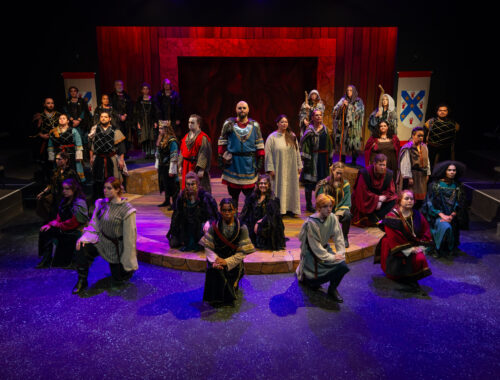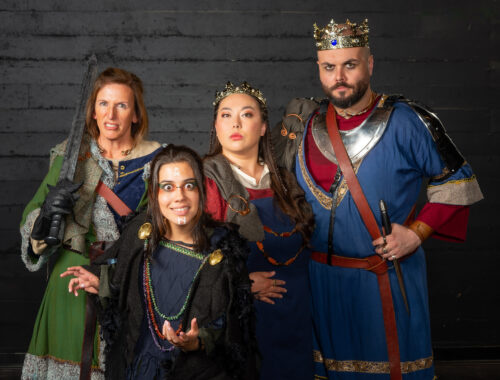Meet the Cast – Julius Caesar, Pt. 9


Eva Hernandez – Cato
Eva is honored to be working on a first show with Sacramento Shakespeare Festival. This is Eva’s first time on the stage in 5 years! Eva is normally behind the scenes or Stage Managing. Eva has previously Stage Managed EURYDICE and SWEAT at Sac City College; POODLE WITH THE GUITAR AND DARK GLASSES with Happy Hour Theater; SHE KILLS MONSTERS; ALMOST, MAINE; and ALL SHOOK UP with C.K. McClatchy High School; and the Annual One Act Festival at Big Idea. Eva was a Stage Management Intern at Broadway Music Circus working on shows such as THE COLOR PURPLE and SOMETHING ROTTEN and is currently working at Capital Stage from time to time.
Tem Huerta – Lucius
Tem is a soon to be sophomore at Sacramento City College. This is Tem’s fifth show on the SCC stage. Tem has been in EURYDICE, MOTHER GOOSE (Tamilda), SWEAT (Oscar), and EMILIA (Lady Katherine) at Sac City.
Meet the Cast – Julius Caesar, Pt. 5



Katherine Folsom – Soothsayer/Citizen 5
Born in San Jose, CA, Katherine started dancing at the age of three and became a teaching apprentice at the age of 13. She has been doing Musical theater choreography since 2002 for musicals such as THE MUSIC MAN; GREASE and EVIL DEAD: THE MUSICAL. Some of her favorite major acting roles have been Robyn in GODSPELL, Marcy in 25TH ANNUAL PUTNAM COUNTY SPELLING BEE and was nominated for an Elly award for the part of Snoopy in YOU’RE A GOOD MAN, CHARLIE BROWN. She received her professional dramatic acting training at The Pacific Conservatory of Performing Arts, receiving the ‘Jan Severson Scholarship’ for excellence. And was cast in their professional regional theater’s productions of WHITE CHRISTMAS and A MIDSUMMER NIGHT’S DREAM. She returned to the Sacramento Area where she teaches dance full time. When she is not on stage, Katherine loves to skateboard and is featured in a new skateboard documentary, “N-Men: The Untold Story” that has been recently released.
Riley J Burke – Claudius
This is Riley’s fourth production with City Theatre (EMILA/Howard/Eve, EURYDICE/Orpheus, MACBETH/Murderer/Seyton) and they are so excited to be back for this year’s Sacramento Shakespeare Festival! RJ has also been involved in productions at the Folsom Lake College campus appearing in two Falcon’s Eye Theatre productions in the last year; CABARET/Ensemble and ANTIGONE/Ismene. Riley recently had the opportunity to be invited to be a part of the World Premiere of AN HONEST APOLOGY/Ella at Free Fall stage earlier this year and she will be participating in HELP ME/Stella with the company in August. RJ is originally from the Greater Bay Area and some early credits include: ALMOST MAINE/Sandrine, MIA/Immaculate, ANGEL STREET/Nancy, THE VAGINA MONOLOGUES, and PICASSO AT THE LAPIN AGILE/Suzanne. RJ plans to study musical theatre well as continue exploring other theatre avenues such as stage management, directing and fight choreography.
Robert Espinosa – Metellus Cimber
This is Robert’s return to the stage after a long hiatus. He studied Theater Arts at San Francisco State University and has been in many productions, including GLENGARRY GLEN ROSS/Aaronow, MAJOR BARBARA/Undershaft, TARTUFFE/Damis, NOISES OFF/Lloyd Dallas, and KILLER’S HEAD/Mazon. When not traveling with his wife or spending time with his dog, Robert runs his dog daycare that he has owned and operated in downtown for over 15 years. But he is most excited about being part of a Sacramento Shakespeare Festival production and looks forward more shows with them in the future.
Meet the Cast – Julius Caesar, Pt. 4



Marco Tabayoyon – Cinna
Marco is absolutely thrilled to be making their Sacramento Shakespeare Festival debut as Cinna the Conspirator. Marco is a local actor with an associate’s degree in theatre arts from San Diego City College, with hopes to find their BFA in acting next year! Some of Marco’s favorite credits include – MUCH ADO ABOUT NOTHING (Big Idea Theatre) AIRNESS ,(ARC Theatre) MY CORNER (Teatro Espejo), and THE MOUSETRAP(FreeFall Stage). Outside of theatre Marco loves taking walks in nature, and going to the movie theaters. Marco hopes someday to break into more film work, while still balancing their love for theatre!
Matthew Fairall – Marcus Brutus
Matthew Fairall is thrilled to be joining this marvelous cast in his premiere show at the Sacramento Shakespeare Festival. He was last seen at PCT’s production of VANYA AND SONIA AND MASHA AND SPIKE – Spike. He was most fond of his time at The Actor’s Workshop with the great Ed Claudio, there seen in THE TAMING OF THE SHREW – Petruccio, DEATH OF A SALESMAN – Biff, KING LEAR – Edmund, and with the Walking Shadow Players in MACBETH – Macduff, and WAITING FOR GODOT – Estragon. In addition, he has been seen at Celebration Arts, POLAR BEARS, BLACK BOYS, AND PRAIRIE FRINGED ORCHIDS – Tom; Capital Stage, THIS PLAY IS NOT ABOUT MONICA LEWINSKY- The Expat, B Street Theatre, STOP KISS – Peter, and Resurrection Theatre, BALM IN GILEAD – Fick. His other interests include SCUBA diving, being mischievous, and the Oxford comma.
Esmeralda – Citizen 4
Esmeralda is extremely grateful to be making her Sacramento Shakespeare Festival debut. As a Theater major at Sacramento State, she has studied for the past two years and is ready to put her skills to practice. She has wanted to be an actor since she was young, and is extremely grateful for the sacrifices her family has taken to grant her the opportunity to follow her dream. This is her first professional production, and is ecstatic to be given this opportunity. She would like to thank the directors for choosing her to be a part of this talented group. Her cast and crew all were so lovely to work with. And her friends and family who have supported her throughout her life.)
Meet the Cast – Julius Caesar pt. 2



Ted Muhlhauser – Strato
Ted is a legislative and legal office manager for the State of California by day. Joining the Sacramento Shakespeare Festival is a bucket-lister for Ted. In 2021, Ted got his first taste of Shakespeare when he played the Bard of Avon’s ghost in City Theatre’s online production of HOME FOR THE HOLIDAYS: WELCOME BACK (GHOSTLIGHT 2). Although Ted has bounced around California local theatre for five decades, this is the first time he takes the stage in a play written by Shakespeare. Ted’s prior stage credits include MR. BURNS, A POST-ELECTRIC PLAY/HOMER ACT 3, FROGGY LESUEUR in THE FOREIGNER, and FRED in Edward Albee’s THE LADY FROM DUBUQUE.
Photo by Bruce Clarke
Anna Colatrella – Flavius/Citizen
Anna is excited to be returning for her second show with Sacramento Shakespeare Festival. Originally from Sacramento, Anna is a rising senior at the University of Hartford, where she will be graduating with a BFA in Musical Theater and a minor in Marketing in the Spring of 2025. Previous roles include Juliet/ROMEO AND JULIET (Sacramento Shakespeare Festival); Quincey/Bart/MR. BURNS (The Hartt School); and By My Side/GODSPELL (Musical Mayhem Productions). She hopes you enjoy the show!
Photo by Bruce Clarke
Jonathan Plon – Mark Antony
Jonathan is thrilled to be returning to the Sacramento Shakespeare Festival this year for JULIUS CAESAR. He earned his B.A. in Theatre 2023 at Sacramento State University, and, in the same year, he completed the Irish Summer Theatre Programme at the Gaiety School of Acting in Dublin, Ireland. Previous credits include: A MIDSUMMER NIGHT’S DREAM/Oberon at Resurrection Theatre, ROMEO AND JULIET/Friar Laurence, and HAMLET/Hamlet for Sacramento Shakespeare Festival, POODLE WITH GUITAR AND DARK GLASSES/Gray at The Happy Hour Theatre, HAMLET/Claudius and THE 25TH ANNUAL PUTNAM COUNTY SPELLING BEE/Paunch at Sacramento State University, as well as A CURIOUS INCIDENT OF THE DOG IN THE NIGHT TIME/Ed Boone at Sacramento City College.
Photo by Bruce Clarke
Julius Caesar 1922 Opens July 5
“Friends, Romans, Countrymen, lend me your ears.” ~ Marc Antony
Jealous conspirators convince Caesar’s friend Brutus to join their assassination plot against Caesar. To stop Caesar from gaining too much power, Brutus and the conspirators kill Caesar on the Ides of March. Mark Antony drives Brutus and the conspirators out of Rome, and there is war. Still Shakespeare’s original text, but set in 1922 Italy, as the rise of fascism propelled Italy toward World War II. A cautionary tale?
Sacramento Shakespeare Festival presents Julius Caesar by William Shakespeare, from July 5 through July 28. Julius Caesar opens Friday, July 5 at 7:30 pm, followed by a sparkling dessert reception in the Chris Daubert Courtyard for the Arts (all are welcome). Performances continue on July 6, 12, 13, 18, 19, 20, 25, 26, 27 at 7:30 pm, and July 7, 14, 21, and 28 at 2:00 pm. All performances will be held in the Art Court Theatre in the Performing Arts Center on the campus of Sacramento City College at 3835 Freeport Blvd. Ticket prices for Julius Caesar are $20 General Admission; $15 for Seniors, Veterans/Military Personnel, and Persons with Disabilities, and $10 for Students. Tickets may be purchased online, or in-person one hour before the performance begins. All details and tickets are available online at www.sacramentoshakespeare.net.

Phoenix Brewer as Caius Cassius, Matthew Malone as Octavius Caesar, Juliuanna Schultz as Calpurnia, Sarah Palmero as Julius Caesar, & Matthew Fairall as Marcus Brutus. Photo by Bruce Clarke. 
Matthew Malone as Octavius Caesar, Sarah Palmero as Julius Caesar & Julianna Schultz as Calpurnia. Photo by Bruce Clarke. Auditions – Julius Caesar 1922
Auditions for our summer festival 2024!!
Saturdays, May 4 & 11, 2 – 5 pm in the Art Court Theatre.
All roles open, and you will be doing readings from the script. We are looking for 25 actors.
Please bring a headshot, resume, and conflicts to auditions.
All participants are required to register for a minimum of 1 unit in our theatre performance series. More information will be given to the cast and crew after casting is complete.
Questions? Email Lori Ann.
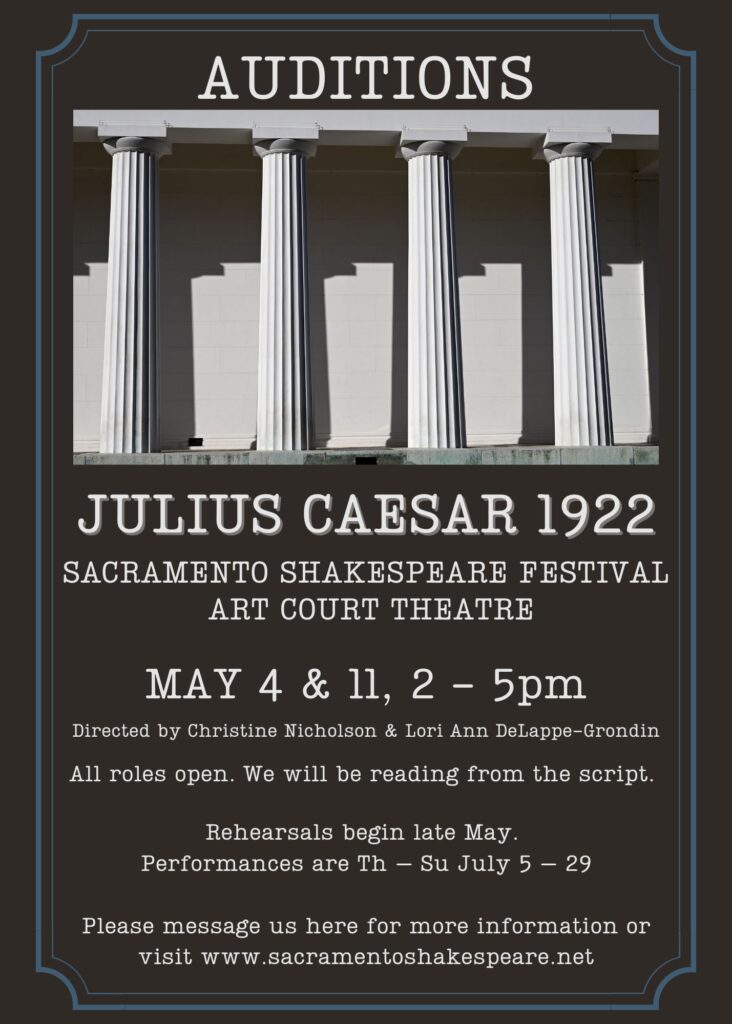
Director’s Notes – Christine
Macbeth opens July 7 and runs through July 23. Tickets available.
I love “Macbeth.” Let me just start with that. To me it is the most perfect of Shakespeare’s tragedies (and that is with great apologies to “Hamlet” and “King Lear,” both if which I dearly love). It packs so much into its two hours of playing time, revealing so much about the human psyche. There are those who disagree with me, who think that the structure is weak- that the second half of the play breaks or undermines the momentum of the narrative right about the time most tragedies are nearing the climax of the action. Heck, Shakespeare even inserts three long scenes between characters who are not Macbeth, one that is ten minutes long and that includes no death or mayhem.
But, to me, that is part of the power of the play. In the first half we see a “good” person seduced by the idea of power and status, and we watch as he justifies his own moral decay along with some incredibly despicable actions to achieve power. In the second half, we see how actions affect others, how one person’s actions and desires can influence and change the lives of others for better, or, in this case, much worse. And then we watch as people of all walks decide to act for the good, even in the face of the same challenges that beset the tyrant. Oh, and there are sword fights.
This is also the first time I’ve co-directed with someone. Lori-Ann and I have worked together for a long time, as actor/director, director/stage manager/actor/actor, and we work well together. I think that we both complement each other and fill in each other’s gaps. It’s been a wonderful collaboration. It is a fairly well-known theatrical fact that there are usually more women than men who audition for plays – at least two to one. And that Shakespeare, because he wrote in a time that women were not allowed on stage, wrote plays with no more than three women (maybe four, once in a while). We both also wanted to find a way to include as many of the people who auditioned for us (In fact, we were able to cast pretty much everyone who auditioned for us and that has been exciting). So, we looked at a time that could incorporate more women as warriors, and that would also be a time that included the possibilities of witches existing. And we settled on Scotland’s semi-mythical past at the moment they kicked the Vikings out of their country. That way we were able to work with many more women and put together the strongest cast possible. We trust you’ll see why.
We have twenty-nine people in the cast and a large crew, a veritable town of people to tell the story of Macbeth, who probably lived in Scotland in the 11th century, and also probably should have become king because he was the strongest and most successful warrior. And I, we, sincerely hope that you enjoy your journey with us into the heart of darkness that is the “Tragedy of Macbeth.”
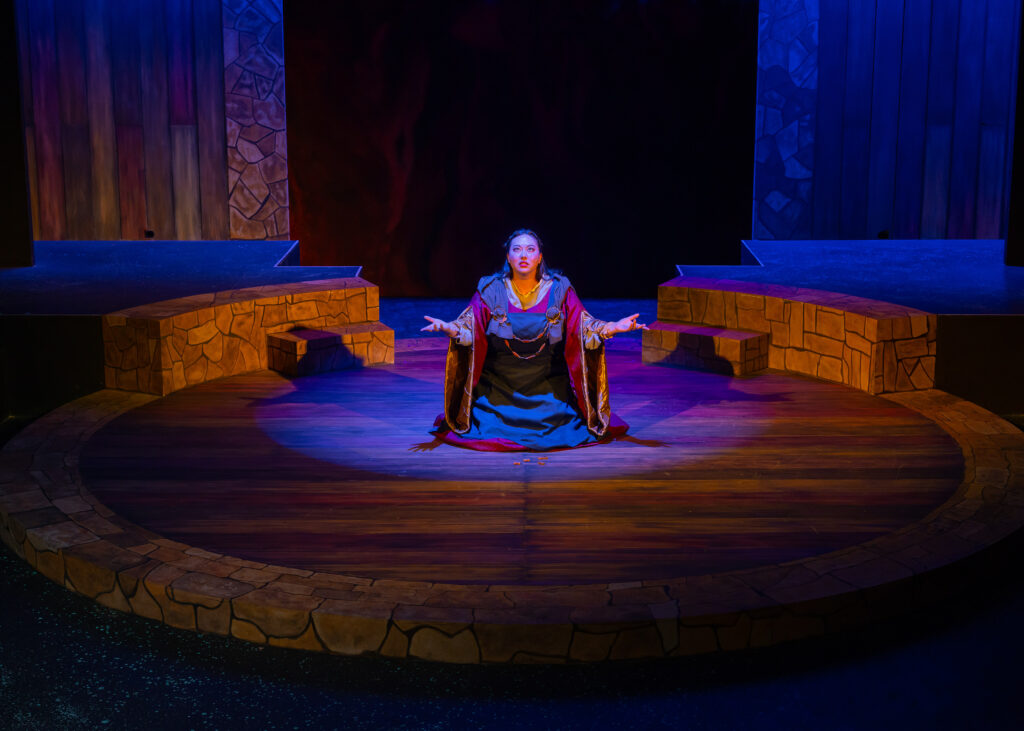
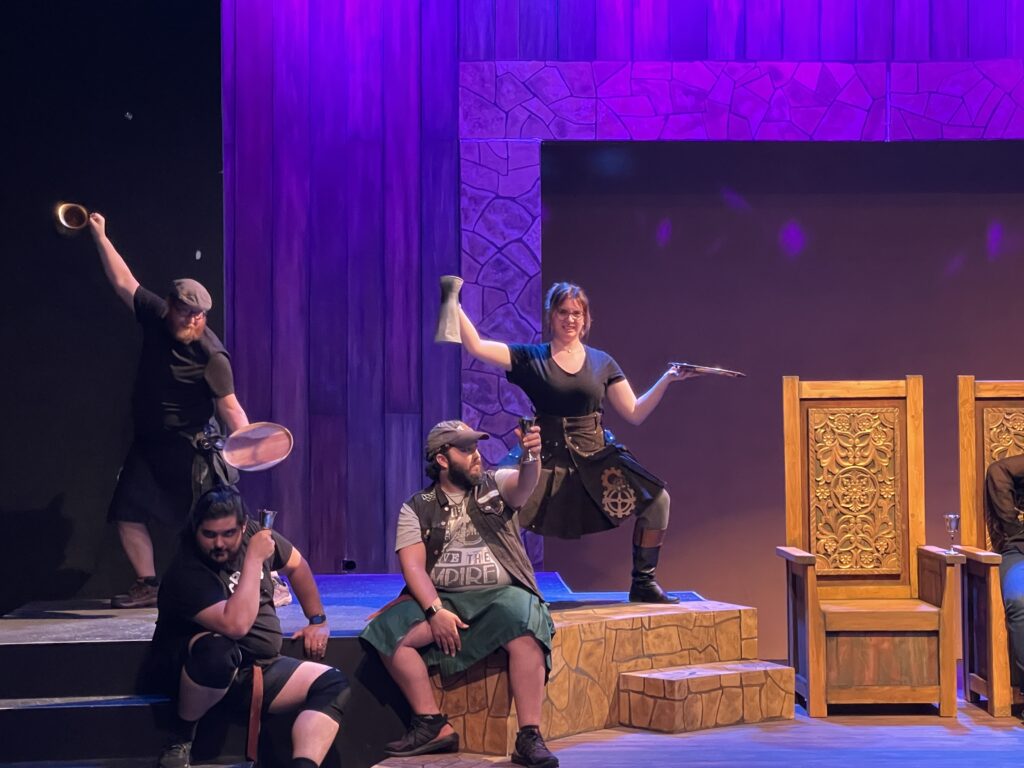
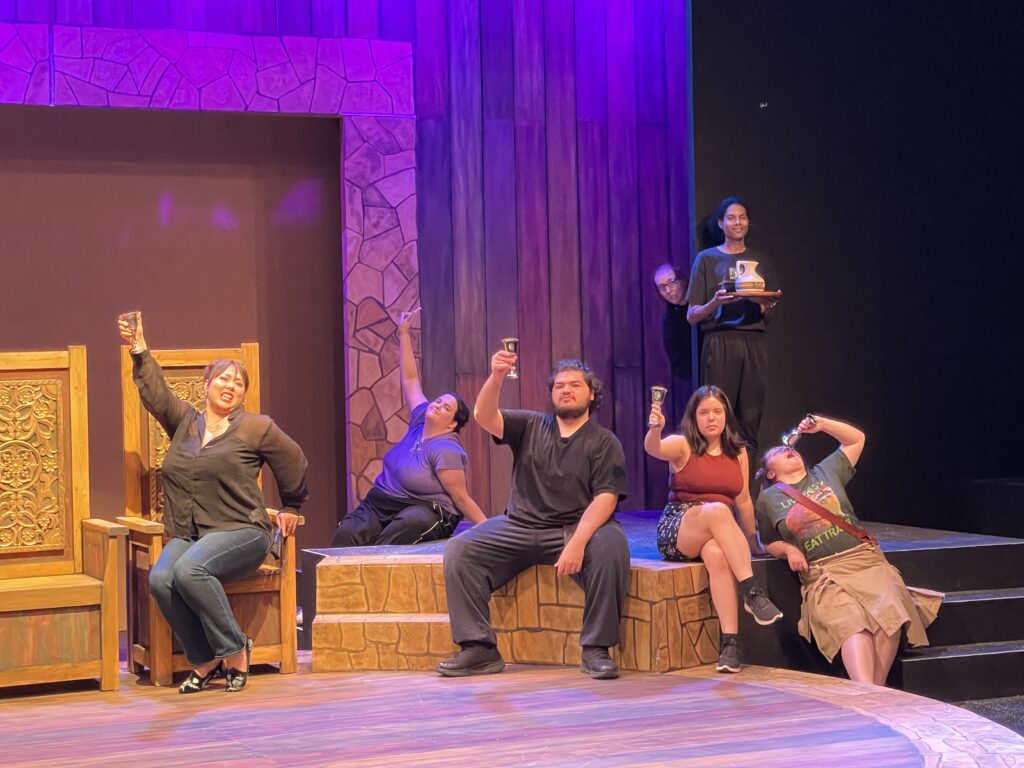
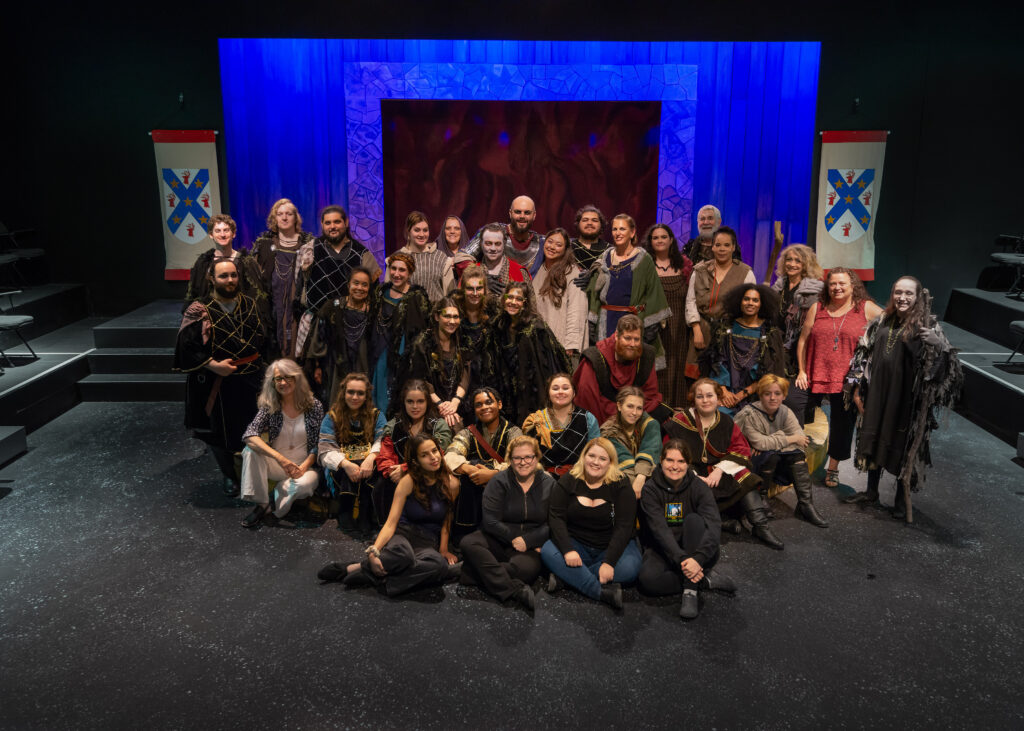
My Make-Up Journey to Witch 1
by Gabriela Llarena
Macbeth opens July 7 and runs through July 23. Tickets available.
Makeup has always been a tool for self-expression and identity. In modern days, makeup is
often viewed in an artistic sense and a skilled artist can entirely transform their face. Within
the theater, makeup is used to enhance the storytelling for two very important reasons:
characterization and clarity over distance. In layman’s terms: the audience needs to know who
you are and what you are expressing from a distance.Theater is the reason I began doing my own makeup and the lockdown of 2020 gave me plenty
of free time to explore. When I got cast as Witch 1 for the show, my mind immediately got
excited at the opportunity to have a creative makeup look! As our show is set during the time
period at the end of the Vikings’ reign in Scotland, makeup is a fundamental support to help drop
the audience into the moment we are playing in. After speaking with our directors, Christine
Nicholson and Lori-Ann Delappe-Grodin, and conferring with our costume designer Nicole
Sivell, I had my parameters within which I could come up with a witch makeup look.
The assignment was this: eyeshadow of earth tones (greens/browns), white lines, and minimal
makeup around the mouth. I asked if I could include runes in the look and was given the green
light.To be accurate to the time period, the look would need to be colors and styles that would have
been prominent near the 1300s. Traditionally makeup has been used as a form of protection
against sunlight. This plays a part in the longstanding popularity of kohl, a dark mineral that lines
the eyes. Along with the practicality makeup provided, it was often used to identify the
individual’s power or strengths as well as to evoke the gods. The three main witches in Macbeth
are magical and powerful in their own right. The three of us cast in these roles (Gabriela
Llarena, McKenna Sennett, Shelby Saumier) dived deep into the mythology surrounding our
characters and brainstormed how the makeup could enhance the storytelling.
When I finally sat in front of the mirror, I let the makeup tell me where it wanted to go. I started
with brown eye shadow in the inner eye area because I wanted to emphasize a deep-set stare
that would contrast nicely against the brightness of my eye. I blended that out to a deep shade
of green. As the witches were not following the standard kohl look, I wanted to still incorporate
the practical usage of makeup at that time. By having a dark green shadow, it mimics the effect
of providing sunlight protection. Underneath the eye, I went in with a brown shadow that would
blend out into the skin. The witches live in the dirt and the forest, constantly getting into
mischief, so this is to further showcase the difference between the witches versus the rest of the
humans in the play. It felt wrong to have the right side disconnected from the left side so I used
a simple line over the nose to bring the look into unity.I ended the look by combining the directors’ desire for white lines with the usage of runes. With
white eyeliner, I drew on 3 runes: gateway, breakthrough, and disruption. Gateway and breakthrough
went on my forehead. I’ve been playing my witch as someone who loves mind games so a large
source of my power comes from my ability to break into other’s minds. The rune for disruption
went below my mouth because it is through the prophecies and spells spoken that the witches
create major disruptions and shifts in the play. When I finished the last rune and looked at the
overall effect, I felt confident and powerful – ready to cause havoc. Each witch will have their
own runes that are unique to their character, so if you want to learn more come out to our show!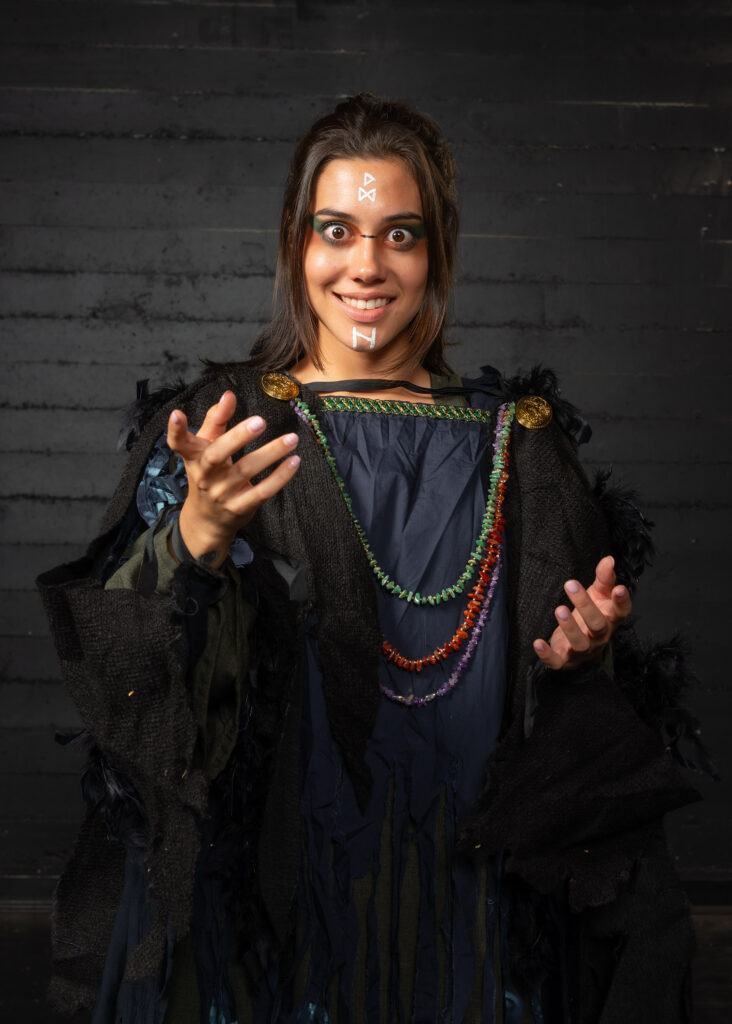
Gabriela Llarena as Witch 1 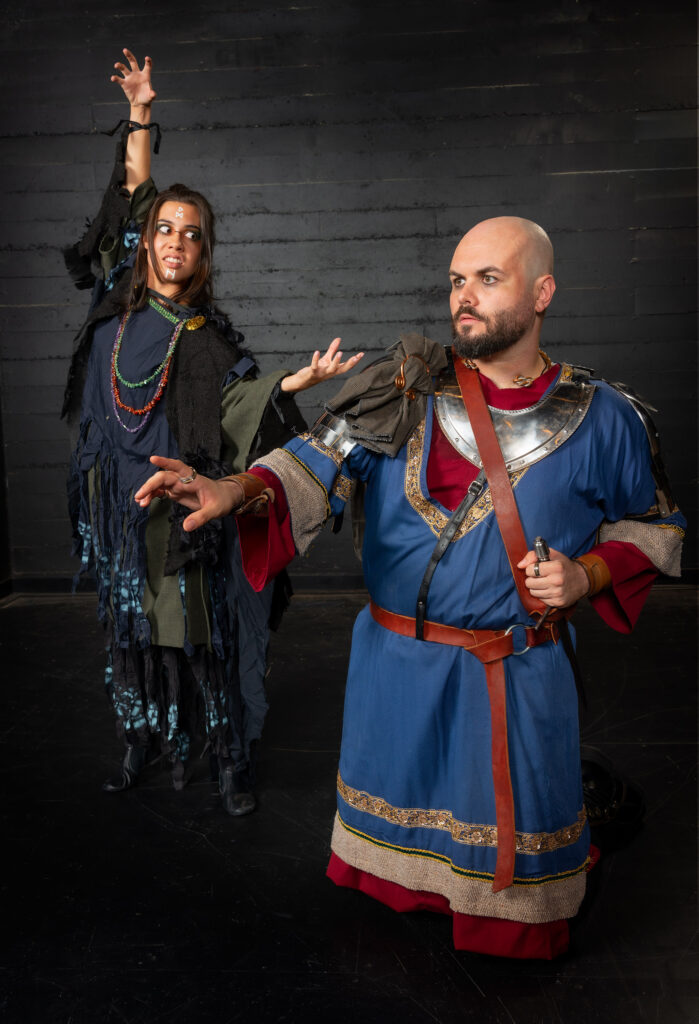
Gabriela Llarena as Witch 1 & Brandon Lancaster as Macbeth 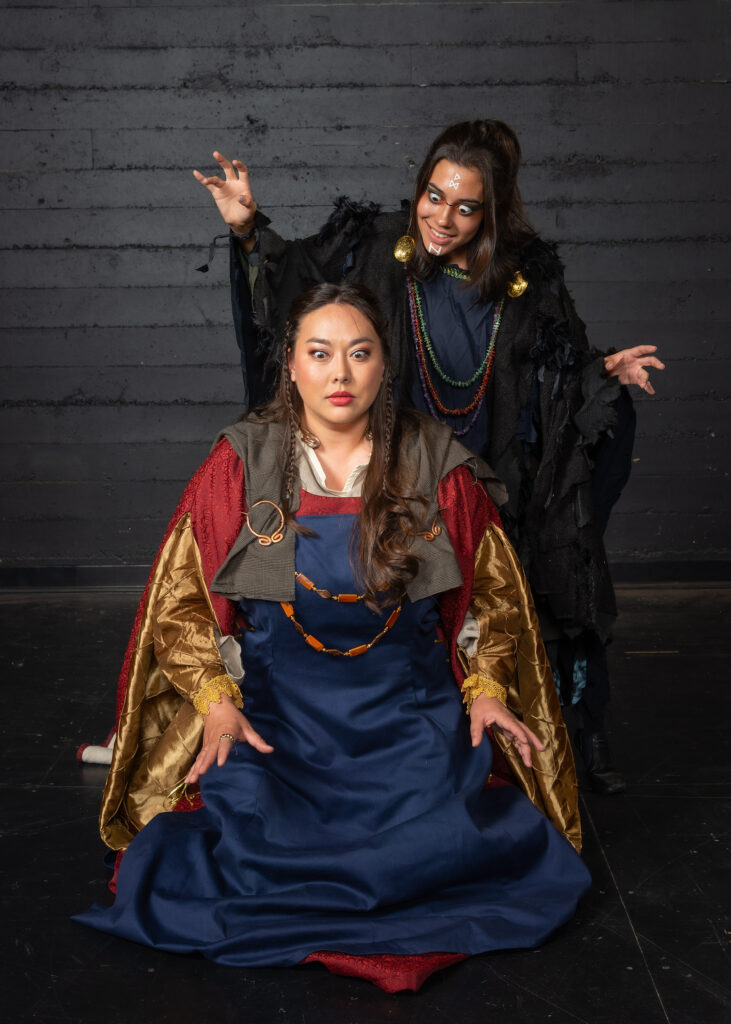
Gabriela Llarena as Witch 1 & Jackie Martin as Lady Macbeth 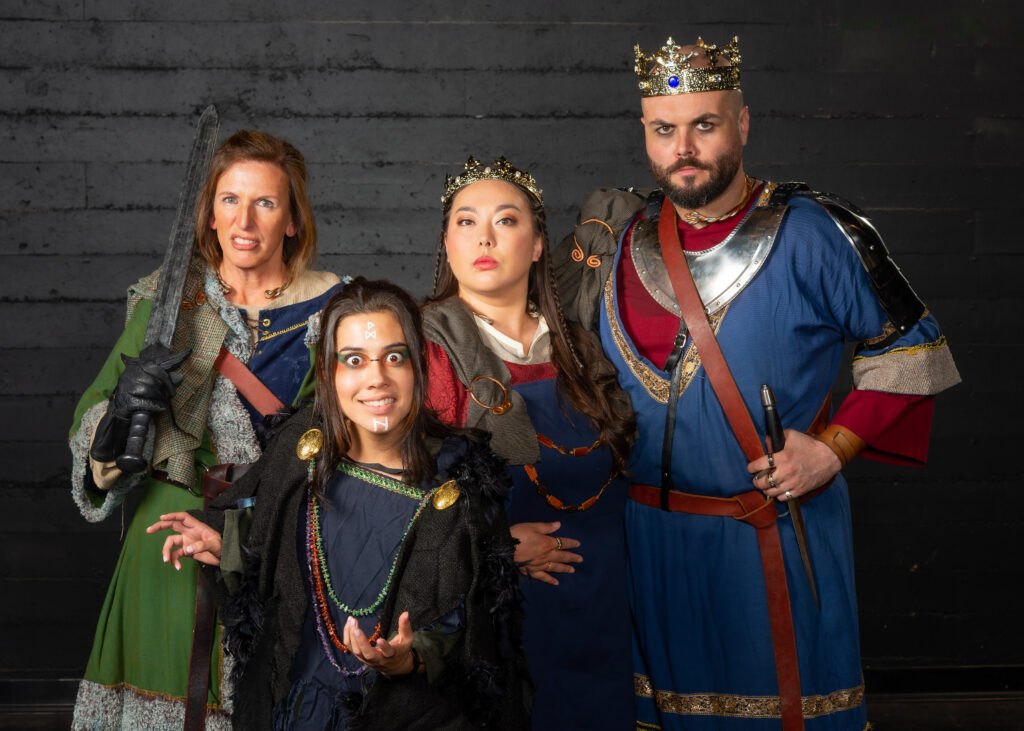
Kathleen Poe as Macduff, Gabriela Llarena as Witch 1, Jackie Martin as Lady Macbeth & Brandon Lancaster as Macbeth The Warriors of Macbeth
Dramaturgical research provided by Lauren Ormond
Macbeth opens July 7 and runs through July 23. Tickets available.
Dramaturgical research helps directors provide context for an existing play. Dramaturgs look into many aspects of the play’s creation, first productions, time periods expressed, and more. For example, when researching a play like “Macbeth,” there are many avenues to pursue. Research areas may include:
- Shakespeare and his time
- Macbeth’s time
- Traditions of the culture the play
- Expanded themes outside of the time it was written or originally set in
- Clothing
- Music
- Art
- Food
- and the list goes on.
Each dramaturg takes their own approach with guidance from the director(s). Our dramaturg, Lauren Ormond, has worked on multiple shows with us now and provides wonderful research for us to build our world on. One of the questions we asked her early on was how to incorporate more female identifying actors in our cast by researching the roles of women in the time we are setting the play.
Our play is set roughly around 1263 in Northern (modern day) Scotland. At this time, there has been over 400 of Viking warfare with the locals. Viking culture had seeped into many aspects of Scottish life, so much so that over 1,000,000 Scots today have Viking DNA, and many town or village names are still Nordic.
Lauren found some amazing information on the women warriors of both cultures. It’s a lot of information, and incredibly fascinating.
Female Warriors Scotland High Middle Ages (900 – 1286 CE)
- SCÁTHACH, TRAINER OF HEROES
- Known as “The Shadowy One” “Warrior Maid”
- Mythology figure seen in 10th century Tochmarc Emire (Wooing of Emer) a legend of the Ulster Cycle in Irish mythology dating to the 10th century
- A Scottish female warrior and teacher of warriors in Celtic mythology
- Lived on an island (thought to be the Isle of Skye) in an impregnable castle, the gate of which was guarded by her daughter Uathach
- Scáthach trained numerous Celtic heroes in the arts of pole vaulting (useful in the assault of forts), underwater fighting, and combat with a barbed harpoon of her own invention, the gáe bolg. Her best-known student was Cú Chulainn, who stayed with her for a year in order to learn the skills that helped him win many battles
- Scottish Island of Eigg
- Roughly translates to “Island of the Big Women”
- Archaeological remains show a group of people known as the Picts resided there and in other parts of Scotland up until the ninth century
- Pictish texts and engravings detail legends of warrior women
- One specific legend details a clan of warrior women residing on An Sgùrr, Eigg’s highest hill
- Pictish Women Warriors
- Engravings from the 1500s based on Roman records describe the Roman army’s encounters with the Picts, and represent both men and women as scantily clad and tattooed warriors
- Engravings of warriors riding side saddle point to the existence of Pictish female warriors
- Scotland in the Middle Ages, like most settings of that time period, was a patriarchal society, and women warriors were not something commonly seen save for desperate moments in history
Female Viking Warriors High Middle Ages (900 – 1286 CE)
- Though the Viking society of the High Middle Ages shows women sharing equal rights with men (they could own land, initiate divorce, serve as clergy, and run their own businesses), their sphere of influence was largely domestic. However, Norse mythology has a great many instances of depicting women joining battle alongside their male counterparts
- These women are described either in the Icelandic sagas of the 12th and 13th centuries CE, in the work of Snorri Sturluson (1179-1241 CE) – an Icelandic mythographer who wrote down and preserved earlier Norse works which had been transmitted orally – or in the historical and semi-historical works of other writers such as the Dane Saxo Grammaticus (c. 1160-c. 1220 CE)
- The most famous type of mortal warrior woman known from the sagas is the shieldmaiden, a woman who took up arms and armor and fought in battle alongside men and who is mirrored in the spiritual realm of the afterlife by the Valkyries
- A real life example of a shield woman was first recovered in 1900 on a farm in Solør Norway, an 18-19 year old girl having been buried with her head resting on a shield, a bridled horse skeleton lay curled at her feet, and her body boxed in by a sword, spear, battle-ax and arrows
- She was the first Viking woman archaeological find with a notable battle wound, a partially healed skull fracture most likely from a sword that had cut her to the bone
- Another Viking warrior woman uncovered in Birka (a Viking settlement in east central Sweden that flourished from about 750 – 950) in 1878 but not proven to be female until 2017 was buried with with an array of weapons and horses, plus a set of chess-like gaming pieces that suggested a tactical aptitude commensurate with a high-ranking military official, leaning towards the fact that she may have been a general
- Though before the High Middle Ages, the best-known semi mythological account of this comes from Saxo Grammaticus in his description of the Battle of Bråvalla (or Brávellir) (c. 750 CE) in his early 13th-century CE Gesta Danorum where he claims 300 shieldmaidens fought for the Danes
- Skadi: Goddess of hunting and skiing
- After her father was killed by Thor, Skadi, who had no brothers, took it upon herself to avenge her father’s death
- Freyja: Goddess of fertility, love, and luck
- Chooses half the dead in battle to reside in the Field of the People, while Odin takes half for Valhalla
- Brynhild
- A Valkyrie who, after supporting the wrong hero in a contest overseen by Odin, is made mortal and is imprisoned in a castle behind a wall of shields, asleep within a ring of fire, until rescued by the champion Sigurd, though is tricked into believing he has forsaken her and instead marries Gunnar, son of the sorceress and wife of King Gjuki. She murders Sigurd and his young son but, realizing her mistake, throws herself into his funeral pyre and rides with him into Hel
- Lagertha: The victorious shieldmaiden
- A figure within Chapter IX of Saxo Grammaticus’ Gesta Danorum (‘History of the Danes’)
- The legendary hero Ragnar Lothbrok comes to Norway to avenge the death of his grandfather Siward and the humiliation of his wives and kinfolk at the hands of Frø, the King of Sweden. He is greeted by a number of women dressed as men who volunteer to help him
- “…among them was Ladgerda, a skilled female warrior who, though a maiden, had the courage of a man and fought in front among the bravest with her hair loose over her shoulders. All marveled at her matchless deeds, for her locks flying down her back betrayed that she was a woman. . .”
- Ragnar forces Lagertha to marry her after the battle, but later divorces her and marries another woman
- Hervor: Wielder of the magic sword Tyrfing
- Hervor is the heroine of the 13th century CE Hervarar saga ok Heiðreks (The Saga of King Heidrek the Wise)
- Hervor’s father, Angantyr, had a magic sword called Tyrfing but was killed in a duel and the sword was buried with him
- Hervor travels with her crew to the island of Samsø in the Kattegat region where Angantyr is buried and summons his spirit, demanding the sword. Her father’s ghost pleads with her to abandon her quest but she will not be denied. Finally, he opens his grave and gives her the magic sword.
- The sword curses its owner with nothing but trouble, and after several adventures Hervor marries and gives it to her son, who is plagued with its curse, before it is given to his daughter Hevor after his death, and she is shortly thereafter killed in battle
- Freydis Eiríksdóttir: Explorer and defender of her party (born circa 970 – circa 1004 CE)
- Portrayed as both either a great woman warrior (Erik the Red’s Saga) or an evil, conniving murderess (The Saga of the Greenlanders)
- In Erik the Red’s Saga, Freydis, daughter of Erik the Red, accompanies a party to Vinland (Newfoundland, North America). They are attacked by a group of natives and the men of the party retreat, leaving Freydis alone. She calls out to them, “Why run you away from such worthless creatures, stout men that ye are, when, as seems to me likely, you might slaughter them like so many cattle? Let me but have a weapon, I think I could fight better than any of you”
- Though hinted at to be pregnant, Freydis grabs a sword from a dead comrade and, tearing open her shirt and beating her breasts with the blade, defies the enemy who retreat from her, thus saving her party
- In The Saga of the Greenlanders she accompanies her husband, his men, and two brothers/business partners to Vinland. She dislikes the brothers and feels they are too presumptuous so she frames them, telling her husband they abused and beat her and that she will divorce him if he does not avenge the insult. Her husband and his men kill the brothers and their party but will not hurt the women so Freydis kills all the women herself with an axe
- It is likely that this second story, written later than the first, is an attempt to discredit the strong female figure from the earlier saga, and it is very likely that Freyda represents a real woman, given sagas concerning Vinland remembered real people and events
- Gudrid Thorbjarnardóttir: Explorer in North America (Vinland)
- Gudrid Thorbjarnardóttir (born 970/980 CE) was the daughter of Erik the Red and among the earliest explorers of North America, according to both The Saga of the Greenlanders and Erik the Red’s Saga
- After her first husband’s death in Greenland, she remarries Thorstein, younger brother of Leif Erikson, and accompanies them to on their expedition to North America where she explored Vinland with the others in the party
- Thorstein died there and Gudrid returned to Greenland where she married one Thorfinn Karlsefni and, sometime later, returned with him to Vinland to establish a permanent settlement there. Their son, Snorri Thorfinnsson, was the first European child born in North America
- Sigrid the Proud: Ruled on her own, killed her suitors
- (927 – 1014 CE, also known Sigrid the Haughty, Sigríð Storråda, or Sigrid Tostadottir), a Swedish queen
- She was married to Erik the Victorious, king of Sweden (970 – 995 CE), and after his death preferred to reign alone. She was courted by Harald Grenske of Norway and Vissavald of the Kievan Rus but recognized that both were only interested in her for her land and wealth. She invited them to a party where, after they and their men fell asleep from too much drink, she barred the doors of the hall and burned them to death to discourage future suitors
- The infamous Olaf Tryggvason (995 – 1000 CE) who converted the populace of Norway to Christianity through torture, allegedly also sought her hand but insisted she convert to Christianity first. When she refused, he slapped her in public and Sigrid vowed revenge. She is said to have then married Sweyn Forkbeard for his connections and power and orchestrated the Battle of Svolder (1000 CE) in which Olaf was killed
- Unn the Deep-Minded: Settled Iceland, commanded her own fleet
- (9th century CE, also known as Aud the Deep-Minded and Unn or Aud Ketilsdóttir) was the daughter of Ketil Flatnose of Norway who fled to Scotland following the rise of Harald Fairhair in Norway
- When her father and her son Thorstein died she understood her position in Scotland was precarious and went first to the Orkneys in the north and then to Iceland which she explored before settling down. She commanded a crew of men who were so loyal to her that none would enter into marriage contracts which might jeopardize Unn’s property or power
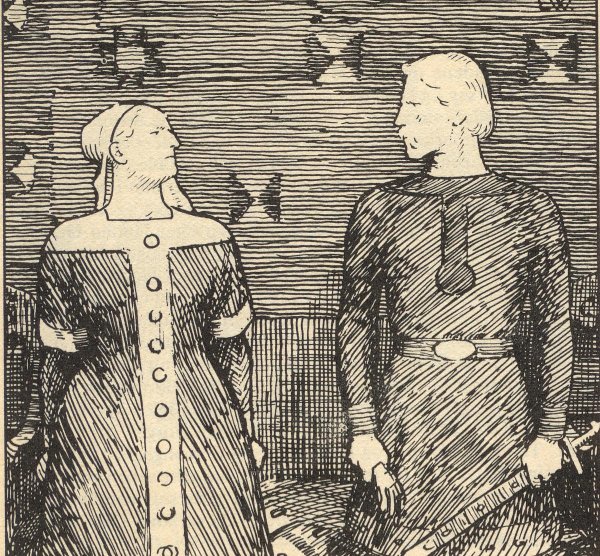
Sigrid the Proud 
Freydis Eiríksdóttir 
Lagertha: The Shieldmaiden

